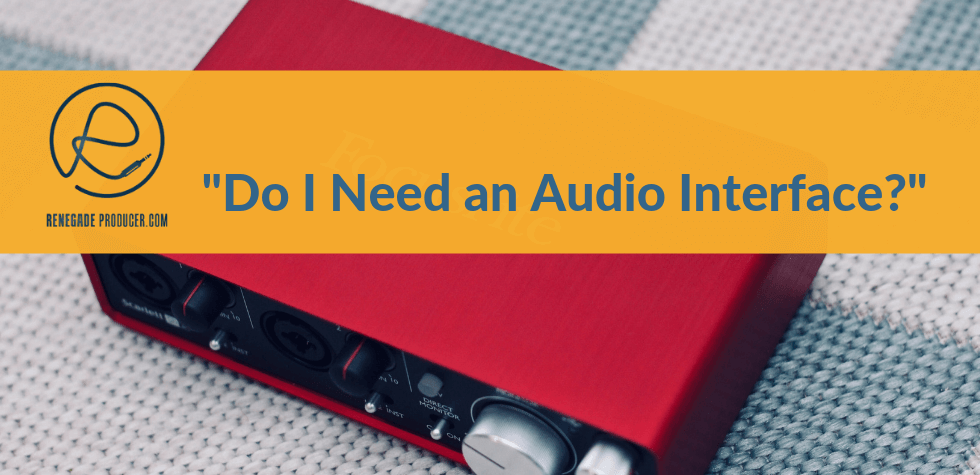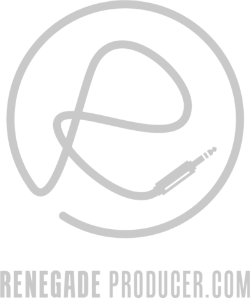25-step music production process checklist and video workshop >>>
Question: “Do I Really Need an Audio Interface? I Don’t Plan to Record Anything at the Moment, I Just Want to Make Beats or Electronic Music…”

Newer producers sometimes wonder if they need an audio interface. Browse just about any music production subreddit or sites like Quora or other music production forums and you'll realize this is a common question.
It’s a very logical and good question to ask because it’s way too easy to spend your hard-earned cash on things you don’t need when you set up your first little bedroom or home studio.
So, in this post we answer the question. But first...
Q: What Does an Audio Interface Do?
Answer: The most basic function an audio interface has is to connect the analog world outside your computer to the digital system inside your computer. In order to do this it has to convert various analog signals to digital code and vice versa.
So, an interface allows you to get sound and other signals into your computer, for example microphones, instruments and other input devices like DIs. This is called Analog to Digital conversion or A/D for short.
It also gets sound out of your DAW or computer for playback in your studio monitors, studio headphones, or for routing to other outboard gear. This, as you may have guessed by now, is called Digital to Analog conversion or D/A.
Most interfaces also come with built-in preamps to amplify your microphone signals as well as phantom power for powering condenser microphones.
Apart from the above main functions, some audio interfaces can provide connectivity for various different input/output formats which could include:
- MIDI
- S/PDIF
- AES
- ADAT
- Various networking formats
You may also find certain interfaces with built-in onboard DSP which can decrease the processing load for your computer.
Q: Does an Audio Interface Improve Sound Quality?
Answer: Yes, a good audio interface provides sound quality improvements over the options you have available in your desktop or laptop in various ways. These improvements include the bit depth and sample rate, better DAC conversion, balanced outputs, mic preamps and headphone amplifiers.
Q: Do I Need an Audio Interface if I Only Plan to Make Beats or Electronic Music and Don’t Need to Record Anything?
Answer: Yes, you need an audio interface, even when you make beats or electronic music.
The main reason is because of the audio quality which is needed for professional music production. This quality is lacking in most sound cards shipped in laptop and desktop computers. The second reason is because of the connectivity provided by the audio interface. Professional studio monitors work best with quality balanced output connector standards which again are absent in most computers and laptops.
In a technical sense you could say you only need a professional-grade soundcard if you’re working completely in the box. This is however usually just a stripped-down interface that’s inside your computer rather than an external box as is the case with a rack-mounted or desktop audio interface.
You also need to consider that although you don't want to record anything straight away you might want to do so as you continue to produce music. You could, for example, want to record in some vocals or acoustic guitar sooner than you may imagine. So, it’s a good idea to at least future-proof your setup a bit so you don’t have to buy a new audio interface when the need for recording something arises.
Q: OK, So I Need an Audio Interface. What Type of Audio Interface Should I Get?
A decent place to start is a small interface with at least 2 inputs, microphone and instrument, and 2 audio outputs. A stereo headphone output is also very handy in addition to the outputs you need for your studio monitors.
These types of audio interfaces range from $40 up to closer to $1000+ in some cases. The main difference will be in the quality of the built-in analog to digital and digital to analog (AD/DA) converters. These converters affect the audio signal quality on the way in while you’re recording and on the way out when you’re playing back your music. These converters are quite crucial when it comes to your sound as you can probably imagine.
Before recommending some of the best audio interfaces for beginner producers or beatmakers to have a look at, let’s first mention the things you need to consider before you purchase an interface for your home or bedroom studio setup:
1. Type of Connection
Various audio interfaces connect to your computer with different
standards which include USB, Firewire and Thunderbolt connections.
Out
of these the most common connection type you’ll find and will most
likely get is USB especially at the lower-end of the price range.
The only other serious contender would be Thunderbolt which you’ll more often run into when you start to shop for higher-end audio interfaces.
Firewire connections have pretty much been replaced by Thunderbolt so you’d be better off for the foreseeable future with a Thunderbolt or USB interface rather than Firewire.
2. Analog Audio Inputs and Outputs
You most likely won’t ever need 16 inputs and outputs as a music producer or beatmaker. Sure, it’s nice to have options but it costs so much more and is only really needed when you plan to record larger ensembles at once. In most cases, as mentioned earlier, you’ll need 2 or 4 inputs max and can get away with the same amount of outputs.
3. Other Connections
Digital connections could be ADAT, S/PDIF and AES/EBU. These connections allow you to expand your interface with more inputs and outputs and connect to other devices, but as an electronic music producer or beatmaker this is rarely needed. Again, nice to have but not essential when you first start out as a producer.
Another connection type you may find is MIDI in and out. This allows you connect MIDI devices directly into your interface. Also, not essential as many controller keyboards and pads connect via USB. This is also nice to have available but also not essential as music producer or beatmaker.
4. Bundled Software
Many interfaces come with Digital Audio Workstation software bundled-in, so this may be a consideration to keep in mind if you don’t already have your chosen DAW. Just remember that the software included will often be a “light” version of the DAW so it may not have all the functionality you want or need.
5. Compatibility
You need an audio interface that will work with your system and music production software. Many, if not most, interfaces will be compatible with Mac OS and Windows and will work with most DAWs. This isn’t true for all interfaces so you definitely want to make sure it’s compatible with your system and software before you hand over your money.
Q: What’s the Best Audio Interface for Beginner Producers and Beatmakers?
A quick browse of music production forums and you’ll realize that this is the question where a lot of “what’s the best” type thread battles start. Most producers believe they have the best interface and will argue about the sound quality until the cows come home. Obviously they cannot all be right!
The question of "which audio interface is the best?" is therefore relative. The more sensible question one has to ask oneself is "which interface is best for my needs?".
The main thing to realize is that, yes,
the sound and component quality will differ and so will the features.
When you first start out it can however be hard to compare quality as
you don’t know what to look and listen for. So, it’s understandable
that you may want a shortlist of good options to start with.
When you first begin to produce and you have a limited budget you should have a look interface ranges from the following manufacturers who all offer viable beginner options at the budget-end of the market:
- Behringer - U-Phoria range
- Focusrite - Scarlett range
- PreSonus - Audiobox range
- Native Instruments - Komplete Audio range
- Steinberg - UR range
Once you’re ready to invest a bit more and feel you need an audio interface with a better quality components under the hood and especially better converters then the manufacturers below offer you excellent professional audio interface options:
- RME - Babyface, MADIface and Fireface
- MOTU - MicroBook, 4pre, Audio Express, Track16
- Universal Audio - Apollo range
- Lynx - Aurora
- Apogee - One, Duet, Quartet
- PrismSound - Lyra
Check out this earlier post if you want a more in-depth look at interfaces and to discover 2 good options to start with.
So, to Summarize…
You need an audio interface if you want to produce professional-level tracks in your home or bedroom studio, regardless of whether you plan to record a lot and only plan to make beats or electronic music.
It’s a good idea to at least have some analog inputs for basic recordings but you can get away with having only 2 physical inputs and 2 outputs for your studio monitors with another output for your headphones.
The quality of the AD/DA converters plays a role in the quality of the audio but even cheaper models of audio interfaces will still provide you with good enough quality to get started with as a producer or beatmaker.
Not only do you need an audio interface, your interface can be seen as one of the core components of your home or bedroom studio and your ability to produce professional tracks. So, this is one place where an extra expense can definitely be justified if your serious about the quality of the music you produce. Just make sure you don’t get a lot of features you’re not likely to use.
A good strategy when you’re really new to the music production game might be to get the cheapest but still decent audio interface when you start out just to get going and start to learn your craft. You can then keep an eye on your progress and upgrade to a higher-end interface at a later stage as your music production skills and budget justifies it.
So, while you need an audio interface without a doubt, you don’t need to feel like you have to buy a really expensive one just to get started!


Learn to understand equalisers and frequencies to supercharge your mixing skills and get results, fast...

New producer? Learn everything you need to produce your first professional track right now...

Would you like to discover the simplest and easiest way to learn music theory as a music producer?
Share this post. Spread the knowledge so other producers can benefit too:
- Renegade Producer
- Home Studio
- Audio Interface
ⓘ Some pages contain affiliate links so I might earn a commission when you buy through my links. Thanks for your support! Learn more

